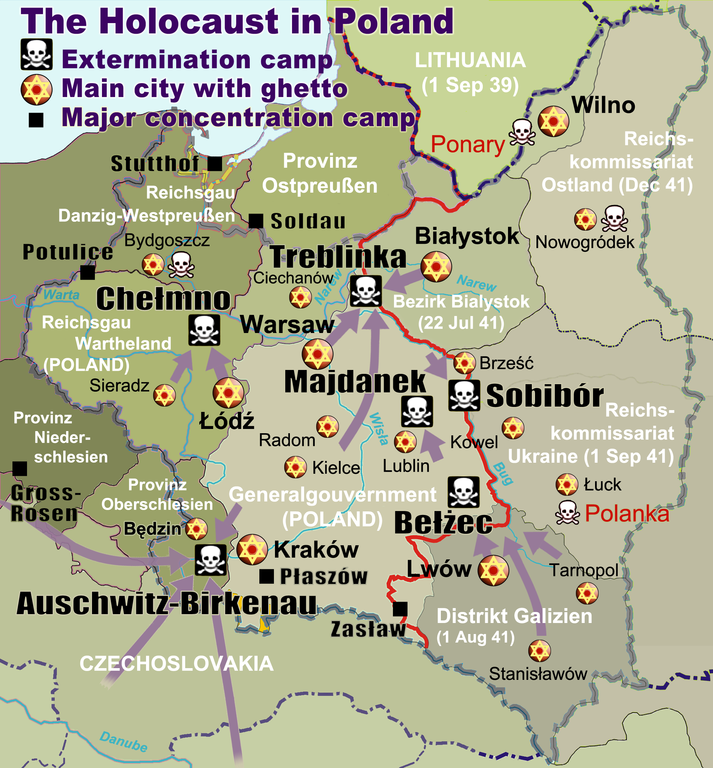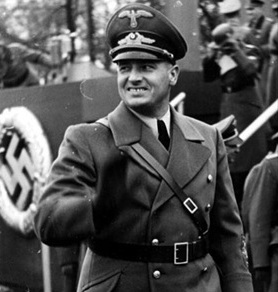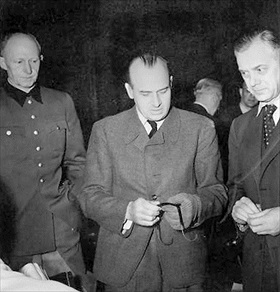LAWYER HANS FRANK TO HEAD OCCUPIED POLAND
Berlin, Germany · October 26, 1939
On this date in 1939 in Poland, 56 days after Germany invaded that country, Dr. Hans Frank, Germany’s chief jurist and one of the most vicious products of Nazism, was appointed Governor-General of the General Government—that half of Nazi-occupied Poland not directly incorporated into the Reich. It included much of Central and Southern Poland, Western Ukraine, as well as the major Polish cities of Warsaw and Kraków.
In a “pacification operation” named Ausserordentliche Befriedungsaktion, or AB-Aktion, during the spring and summer of 1940, Frank approved (on May 16) and oversaw the arrest of more than 30,000 Poles who were suspected of engaging in “criminal [i.e., anti-Nazi] activities.” (Working from lists of names drawn up before the war, some 60,000 Poles were rounded up and murdered soon after the German invasion of Poland.) During the 1940 AB-Aktion, which may have been coordinated with the Soviets in Soviet-occupied Poland, some 7,000 arrested members of the Polish political elite, aristocracy, intelligentsia, and priesthood were massacred, mostly by automatic weapons. Other Poles were sent to German concentration camps, most notably to the newly created camp of Auschwitz in an area of Poland that was incorporated into the Reich, as well as Sachsenhausen (20 miles north of Berlin) and Mauthausen (Upper Austria).
An anti-Semitic fanatic, Frank also oversaw the segregation of the Jews into Polish ghettos. Jews were barred from engaging in a long list of activities: participating in athletic events, walking in public parks, using railroad waiting rooms, having gold fillings, riding in taxis, carrying briefcases, wearing felt hats, calling from phone booths, etc. Frank told his senior officials on December 16, 1941, about the approaching annihilation of the Jews: “Gentlemen, I must ask you to rid yourself of all feelings of pity. We must annihilate the Jews wherever we find them and whenever it is possible.” To that end the General Government became the location of four Nazi extermination camps on Polish soil (see map below).
Frank fled the General Government in January 1945 in advance of the Red Army. Captured by American troops in Bavaria, he was tried during the Nuremberg Trials (1945–1946), found guilty of war crimes, and hanged on October 16, 1946.
![]()
Occupied Poland, Nazi Death and Concentration Camps, and Hans Frank
 |
 |  |
Top: Map depicts borders of Poland up to 1945. For political and logistical reasons, Nazi Germany built most extermination camps in occupied Poland, home of the greatest concentration of European Jewry. Four of seven Nazi extermination camps in Poland were built in Hans Frank’s General Government district: Bełżec not far from a railroad station of the same name, where an estimated 600,000 were killed; Majdanek on the outskirts of Lublin, where 360,000 were killed; Sobibór near the village of the same name, where 250,000 were killed; and Treblinka, where 800,000 were killed. The largest killing complex was at Auschwitz–Birkenau in Western Poland, an area annexed by Nazi Germany in October 1939 and where an estimated 1.1 million people were murdered. In all of Poland, roughly 3.4–3.5 million people were killed in Nazi death camps. One authority claims that between 1939 and 1945 approximately 5.6–5.8 million Poles lost their lives, of whom 3.1 million were Polish Jews, two million were ethnic Poles, and the remaining half-million were minorities; e.g., Roma (Gypsies).
![]()
Bottom Left: SS-Obergruppenfuehrer Hans Frank at a 1939 police parade in Krakau (present-day Kraków), capital of Germany’s new General Government. During his tenure as Governor General (1939–1945), Frank instituted a reign of terror against the Polish population, engaged in the systematic plunder and brutal economic exploitation of Poland, and became directly involved in the mass murder of Polish citizens, both Jews and non-Jews.
![]()
Bottom Right: In this 1945 photograph taken before the start of the Nuremberg War Crimes Trials, Frank can be seen with Gen. Alfred Jodl (left), Chief of the Operations Staff of the (German) Armed Forces High Command (Oberkommando der Wehrmacht, or OKW), and Alfred Rosenberg (right), one of the chief authors of Nazi ideological creeds, including its racial theory, persecution of the Jews, and Lebensraum (“living space”). All three men were convicted of war crimes and crimes against humanity and executed on the same day, October 16, 1946.
Life in German-Occupied Poland: The General Government of Hans Frank (1939–1946)
![]()

 History buffs, there is good news! The Daily Chronicles of World War II is now available as an ebook for $4.99 on Amazon.com. Containing a year’s worth of dated entries from this website, the ebook brings the story of this tumultuous era to life in a compelling, authoritative, and succinct manner. Featuring inventive navigation aids, the ebook enables readers to instantly move forward or backward by month and date to different dated entries. Simple and elegant! Click
History buffs, there is good news! The Daily Chronicles of World War II is now available as an ebook for $4.99 on Amazon.com. Containing a year’s worth of dated entries from this website, the ebook brings the story of this tumultuous era to life in a compelling, authoritative, and succinct manner. Featuring inventive navigation aids, the ebook enables readers to instantly move forward or backward by month and date to different dated entries. Simple and elegant! Click 











